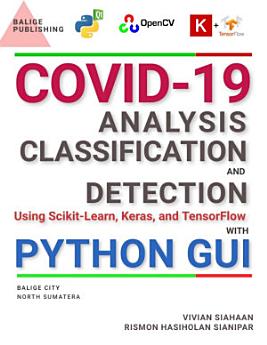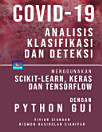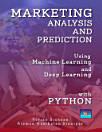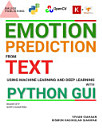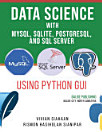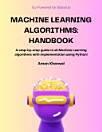COVID-19: Analysis, Classification, and Detection Using Scikit-Learn, Keras, and TensorFlow with Python GUI
About this ebook
With insights gained from data exploration, the project delves into predictive modeling using machine learning. It employs Scikit-Learn to build and fine-tune predictive models, harnessing grid search for hyperparameter optimization. This meticulous process ensures that the machine learning models, such as Naïve Bayes, K-Nearest Neighbors, Decision Trees, Random Forests, Gradient Boosting, Extreme Gradient Boosting, Multi-Layer Perceptron, AdaBoost, and Logistic Regression, are optimized to accurately predict the risk of COVID-19 based on the input features.
Transitioning to the realm of deep learning, the project employs Convolutional Neural Networks (CNNs) to perform intricate image classification tasks. Leveraging Keras and TensorFlow, the CNN architecture is meticulously crafted, comprising convolutional and pooling layers, dropout regularization, and dense layers. The project also extends its deep learning capabilities by utilizing the VGG16 pre-trained model, harnessing its powerful feature extraction capabilities for COVID-19 image classification.
To gauge the effectiveness of the trained models, an array of performance metrics is utilized. In this project, a range of metrics are used to evaluate the performance of machine learning and deep learning models employed for COVID-19 classification. These metrics include Accuracy, which measures the overall correctness of predictions; Precision, emphasizing the accuracy of positive predictions; Recall (Sensitivity), assessing the model's ability to identify positive instances; and F1-Score, a balanced measure of accuracy. The Mean Squared Error (MSE) quantifies the magnitude of errors in regression tasks, while the Confusion Matrix summarizes classification results by showing counts of true positives, true negatives, false positives, and false negatives. These metrics together provide a comprehensive understanding of model performance. They help gauge the model's accuracy, the balance between precision and recall, and its proficiency in classifying both positive and negative instances. In the medical context of COVID-19 classification, these metrics play a vital role in evaluating the models' reliability and effectiveness in real-world applications.
The project further enriches its analytical capabilities by developing an interactive Python GUI. This graphical user interface streamlines the user experience, facilitating data input, model training, and prediction. Users are empowered to input medical images for classification, leveraging the trained machine learning and deep learning models to assess COVID-19 risk.
The culmination of the project lies in the accurate prediction of COVID-19 risk through a combined approach of machine learning and deep learning techniques. The Python GUI using PyQt5 provides a user-friendly platform for clinicians and researchers to interact with the models, fostering informed decision-making based on reliable and data-driven predictions.
In conclusion, this project represents a comprehensive endeavor to harness the power of machine learning and deep learning for the vital task of COVID-19 classification. Through rigorous data exploration, model training, and performance evaluation, the project yields a robust framework for risk prediction, contributing to the broader efforts to combat the ongoing pandemic.
Ratings and reviews
About the author
Vivian Siahaan is a fast-learner who likes to do new things. She was born, raised in Hinalang Bagasan, Balige, on the banks of Lake Toba, and completed high school education from SMAN 1 Balige. She started herself learning Java, Android, JavaScript, CSS, C ++, Python, R, Visual Basic, Visual C #, MATLAB, Mathematica, PHP, JSP, MySQL, SQL Server, Oracle, Access, and other programming languages. She studied programming from scratch, starting with the most basic syntax and logic, by building several simple and applicable GUI applications. Animation and games are fields of programming that are interests that she always wants to develop. Besides studying mathematical logic and programming, the author also has the pleasure of reading novels. Vivian Siahaan has written dozens of ebooks that have been published on Sparta Publisher: Data Structure with Java; Java Programming: Cookbook; C ++ Programming: Cookbook; C Programming For High Schools / Vocational Schools and Students; Java Programming for SMA / SMK; Java Tutorial: GUI, Graphics and Animation; Visual Basic Programming: From A to Z; Java Programming for Animation and Games; C # Programming for SMA / SMK and Students; MATLAB For Students and Researchers; Graphics in JavaScript: Quick Learning Series; JavaScript Image Processing Methods: From A to Z; Java GUI Case Study: AWT & Swing; Basic CSS and JavaScript; PHP / MySQL Programming: Cookbook; Visual Basic: Cookbook; C ++ Programming for High Schools / Vocational Schools and Students; Concepts and Practices of C ++; PHP / MySQL For Students; C # Programming: From A to Z; Visual Basic for SMA / SMK and Students; C # .NET and SQL Server for High School / Vocational School and Students. At the ANDI Yogyakarta publisher, Vivian Siahaan also wrote a number of books including: Python Programming Theory and Practice; Python GUI Programming; Python GUI and Database; Build From Zero School Database Management System In Python / MySQL; Database Management System in Python / MySQL; Python / MySQL For Management Systems of Criminal Track Record Database; Java / MySQL For Management Systems of Criminal Track Records Database; Database and Critptography Using Java / MySQL; Build From Zero School Database Management System With Java / MySQL.
Rismon Hasiholan Sianipar was born in Pematang Siantar, in 1994. After graduating from SMAN 3 Pematang Siantar 3, the writer traveled to the city of Jogjakarta. In 1998 and 2001 the author completed his Bachelor of Engineering (S.T) and Master of Engineering (M.T) education in the Electrical Engineering of Gadjah Mada University, under the guidance of Prof. Dr. Adhi Soesanto and Prof. Dr. Thomas Sri Widodo, focusing on research on non-stationary signals by analyzing their energy using time-frequency maps. Because of its non-stationary nature, the distribution of signal energy becomes very dynamic on a time-frequency map. By mapping the distribution of energy in the time-frequency field using discrete wavelet transformations, one can design non-linear filters so that they can analyze the pattern of the data contained in it. In 2003, the author received a Monbukagakusho scholarship from the Japanese Government. In 2005 and 2008, he completed his Master of Engineering (M.Eng) and Doctor of Engineering (Dr.Eng) education at Yamaguchi University, under the guidance of Prof. Dr. Hidetoshi Miike. Both the master's thesis and his doctoral thesis, R.H. Sianipar combines SR-FHN (Stochastic Resonance Fitzhugh-Nagumo) filter strength with cryptosystem ECC (elliptic curve cryptography) 4096-bit both to suppress noise in digital images and digital video and maintain its authenticity. The results of this study have been documented in international scientific journals and officially patented in Japan. One of the patents was published in Japan with a registration number 2008-009549. He is active in collaborating with several universities and research institutions in Japan, particularly in the fields of cryptography, cryptanalysis and audio / image / video digital forensics. R.H. Sianipar also has experience in conducting code-breaking methods (cryptanalysis) on a number of intelligence data that are the object of research studies in Japan. R.H. Sianipar has a number of Japanese patents, and has written a number of national / international scientific articles, and dozens of national books. R.H. Sianipar has also participated in a number of workshops related to cryptography, cryptanalysis, digital watermarking, and digital forensics. In a number of workshops, R.H. Sianipar helps Prof. Hidetoshi Miike to create applications related to digital image / video processing, steganography, cryptography, watermarking, non-linear screening, intelligent descriptor-based computer vision, and others, which are used as training materials. Field of interest in the study of R.H. Sianipar is multimedia security, signal processing / digital image / video, cryptography, digital communication, digital forensics, and data compression / coding. Until now, R.H. Sianipar continues to develop applications related to analysis of signal, image, and digital video, both for research purposes and for commercial purposes based on the Python programming language, MATLAB, C ++, C, VB.NET, C # .NET, R, and Java.
